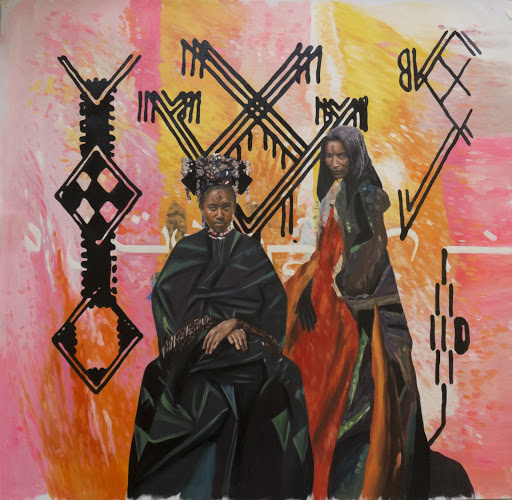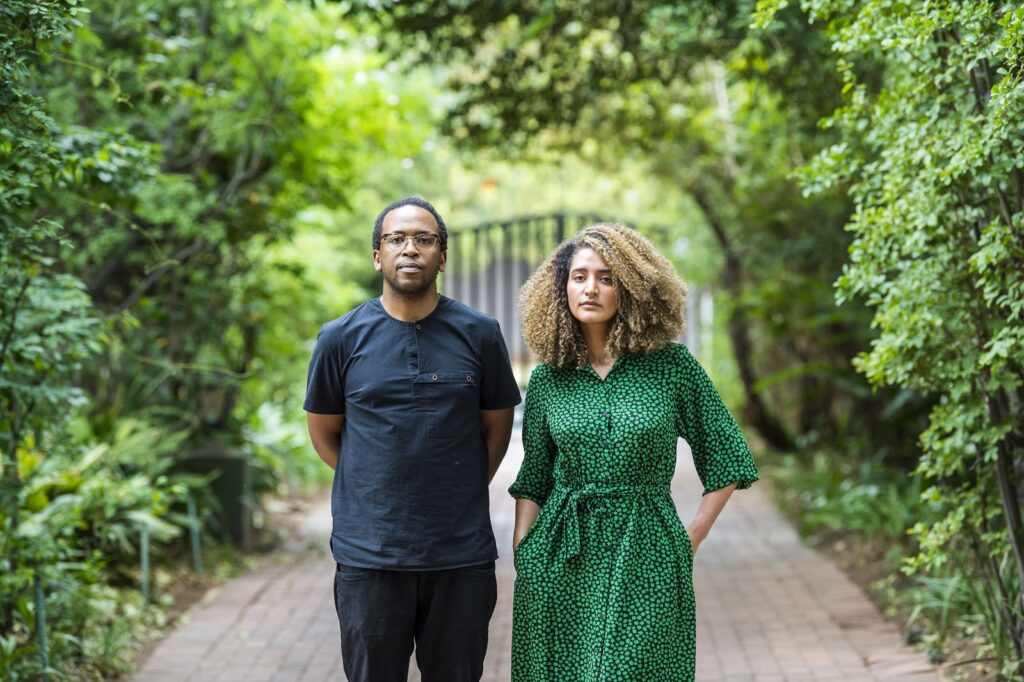Hypatia’s Theory, featured in the Again She Reigns project, also doubles as the cover artwork for the recently released album. (Fonseca and Mokgata)
Although Again She Reigns currently exists as the new Batuk album — as a project concerned with the reclamation of history — it has been years in the making. The joint work of multidisciplinary artists Carla Fonseca and Nthato Mokgata (better known as Spoek Mathambo), surfaced this year as a series of paintings depicting several female historical figures. It was on exhibit at 99 99 Loop Gallery in Cape Town during August before some artworks in the series were shown at the Art3f Luxembourg International Art Fair soon after.
Had it not been for the restrictions of movement during the tougher lockdown levels, audiences would have already seen live iterations of the work as a musical project: the principal producer, Spoek Mathambo, was the recipient of the 2020 2020 Standard Bank Young Artist award for music.
The project pays homage to figures such as Sibongile Promise Khumalo, Negeste Saba Makeda (famously known as the Queen of Sheba), Josina Mutemba Machel, Hypatia of Alexandria, Fezekile Kuzwayo, Dahomey Ahosi, Muthoni wa Kirima, and Perpetua and Felicity.
A series of eight oil paintings (which is currently being expanded), Again She Reigns presents its subjects in regal poses (mostly sitting), dressed in ornate garments and set against dramatic backdrops. Although their thrones are invisible, and their garments foregrounded, the presence of other figures — ephemeral and shadowy — suggests that these women represent more than their solitary selves.
“They stand for women who were misrepresented in our history,” says Fonseca on a Zoom call, with her creative partner, Mokgata, nodding his approval, “… lots of storytellers and griots who were killed and many of our leaders, from BC to even 20 years ago, who were killed and replaced with European faces.”
What Mokgata and Fonseca are aiming to achieve is a way to give voice to “violence as a language” and, from there, lay bare the continuity of that violence.
“There was a wide range of women whom we discussed [including with] the possibility of learning more about their stories,” says Mokgata. “By the time we got it down to a set of them that interested us in their various fields, we found that there was a martyr story underlying: women who just gave to society and that same society just flipped on them.
 Perpetua and Felicity were two Chistian women in Carthage put to death for their faith by the Roman empire. (Fonseca and Mokgata)
Perpetua and Felicity were two Chistian women in Carthage put to death for their faith by the Roman empire. (Fonseca and Mokgata)
“In Hypatia’s case [a mathematician and philosopher], it was chanting down her anti-religious side. With Perpetua and Felicity [two Christian women who refused to worship Roman gods], it was them being religious. With Khwezi [who accused former president Jacob Zuma of rape], it was growing up in the ANC and having that machine being the thing that comes for her.”
Through its visual and sonic components, the project examines various ways of speaking back, with one evocative motif being the representation of embroidery through brush strokes.
Embroidery itself is a craft the artists are still mastering. “At some point in the process we had a conversation with Same [Dr Same Mdluli, current gallery manager at Standard Bank Gallery] and she was showing us some embroidery done by Xhosa women artists, and some other Ndebele ones. She was saying a huge aspect of our artistic expression comes from those forms. In these times, siwashiye in the crafts section, which, in a way, is a form of gender chauvinism.”
 Nthato Mokgata and Carla Fonseca have recently a musical version of their ongoing project Again She Reigns. (Delwyn Verasamy)
Nthato Mokgata and Carla Fonseca have recently a musical version of their ongoing project Again She Reigns. (Delwyn Verasamy)
In addition, “it is a way of not taking the African arts seriously”, adds Fonseca. “The days of scientific skill that go into carving a mask or completing an embroidery [are often not fully appreciated].”
Overall, the backdrops of the artworks enhance a sense of omnipresence, alluding to the martyr status bestowed on the women represented in the series.
“The series is very ancestrally based,” says Mokgata. “That’s a plane we are tapping into to get through the bullshit to get to what comforts us as the truth. With [Mozambican revolutionary] Josina Machel, in particular, we were exploring how a lot of people’s identities get obscured.
“With the other women, we wanted to show their faces, but a big part of it is the obscuring of people’s identities. In that ancestral plane, there are no faces; we have to try and tap into our mothers for healing.”
In what Fonseca terms the “architecture of the garments”, as opposed to their design and detail, another layer of contemporary concerns is alluded to.
Even with this confluence of mediums, it is as a work of sonic art that Again She Reigns finds firm footing. It is also in this realm that it becomes reverend, meditative and light, although — as in the paintings — an underlying tension exists, one mostly expressed by the drums.
 Negeste Saba Makeda, as depicted in Again She Reigns, a project that seeks to highlight the stories of African women distorted by history. (Fonseca and Mokgata)
Negeste Saba Makeda, as depicted in Again She Reigns, a project that seeks to highlight the stories of African women distorted by history. (Fonseca and Mokgata)
Fonseca’s lyrics, sung in various languages but mainly Portuguese and English, are economical: sometimes allusive and sometimes direct, relying on mostly the open melodies of hooks to achieve a hymnal quality. It is a beguiling set of songs, filled with sophisticated tapestries of drums that animate Fonseca’s prayers without directly intruding.
There is a majesty, pomp and pageantry, but most of all, there is a softness. On the other side of that is a gnawing: feasts of decaying flesh and valleys of skeletons, all conjured primarily by some intuitive drum programming.
Through a careful tincturing of, at times, contrasting elements, Fonseca and Mokgata conjure a perfectly attuned soundscape in which, surprisingly, it is not warm chords and guitar licks that do most of the heavy lifting.
This may be in the realm of house, but it is repurposed. For dance, yes, but for other ways of communing, too. “Artwise, we were in a zone and, creatively, I started to understand beat-making in another way,” says Mokgata. “I hadn’t [fully] understood how rhythm works in a South African house music context… That the bassline, the snare and the drums, push and there is a counter to that, but things are working in tandem.
“It’s a lot of syncopation and the sense of a machine moving back and forth. Once I understood that, the percussion stuff came, the synth stuff came and the bass stuff came.”
What is perhaps most refreshing about Again She Reigns, and the routes it is yet to take, is the knowledge that, for the artists, it is a language in progress; a way of confronting the horrors of the past so that a present, however constrained, may come into view.
Batuk’s Again She Reigns (Teka Music) is out on 30 October 2020. The album is available on all digital streaming platforms